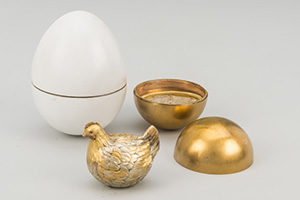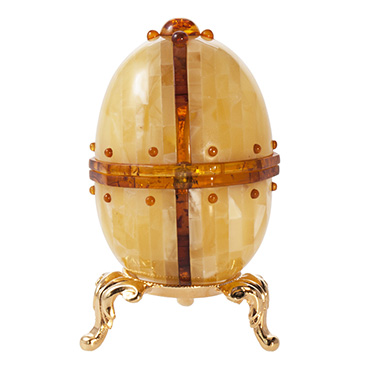|
The late 19th and early 20th centuries marked an era of unparalleled flourishing in fine, decorative, and applied arts. Craftsmen gained access to cutting-edge technologies previously unimaginable, and a relatively tranquil socio-political environment fostered patronage. Across various crafts, professionals crafted genuine treasures for the affluent, aristocrats, and collectors. Our article and materials on ukrburshtyn.com will delve into this fascinating world, spotlighting one prominent figure.

Carl Fabergé - Roots, Biography, Industry Secrets
The prodigious talent behind the jewelry empire, Carl Fabergé, entered the world on May 30, 1846, in St. Petersburg. A blend of diverse ancestral roots shaped him. Huguenots, refugees from religious persecution in northern France, altered their surname Favry upon fleeing to Prussia. His father, Peter Gustav, a Baltic German, migrated from Livonia to Russia, while his mother, Charlotte, hailed from a lineage of Danish artists.
From an early age, young Carl absorbed a fervor for creativity and diligent work. His family had already established a prestigious shop on Velika Morska Street by then. His father aspired for him to replicate and surpass his success. Thus, Carl received tutelage from the finest sculptors, graphic artists, and painters. At 18, he embarked on a European tour, visiting Paris, Saxony, Frankfurt, Dresden, Venice, and Morocco. This journey exposed him to antique galleries, museums, and the techniques of various craftsmen.
Upon his return in 1864, Carl dedicated himself to restoring ancient artifacts from the Hermitage. However, his father's illness in 1872 compelled him to assume leadership in the family business. The knowledge accumulated during his travels didn't dissipate. Under his management, the staff expanded from around 100 to over 500 craftsmen of diverse nationalities—Russians, Finns, Germans. In 1882, Emperor Alexander III noticed Fabergé's jewelry, ordering a copy of an 18th-century snuffbox. Upon inspection, the king couldn't distinguish it from the original. This earned Carl the title of "court goldsmith" and the right to imprint a state seal—a double-headed eagle—on his creations.
The Romanovs became patrons, acquiring surprises from Fabergé. The company's reach extended to monarchs worldwide, producing up to 200,000 masterpieces, from cutlery to furniture. Karl himself served as an expert and jury chairman at exhibitions.
.jpg)
Innovative Techniques and Noteworthy Works
Fabergé's success lay in the innovative approach of craftsmen like Mykhailo Yevlampievych Pershin, creator of the famed eggs. They blended precious stones with manufactured ones, avoiding excessive soldering and ensuring stability with tiny fasteners, screws, and nuts. Enameling introduced a technique called "guilloche," creating patterns with parallel vertical and horizontal stripes, herringbone notches, scales, and lightning.
The concept of gifting Fabergé eggs for Easter originated in 1885 when the Tsar ordered one for Maria Feodorovna. Inspired by Danish traditions, the first attempt featured a frosted gold yolk within the main egg, a chicken with mosaic feathers, a miniature crown encrusted with pearls, and a ruby pendant.
Subsequent creations showcased refinement and intricacy. Examples include "Danish Palaces" (1890) with engraved vignettes and sapphires, "Memory of Azov" (1891) depicting an armored cruiser, and "Resurrection of Christ" (1894), a sculptural group. The collection culminated in the monumental "Moscow Kremlin" (1906), depicting detailed church interiors.
.jpg)
Surviving the Test of Time
Since 1885, 71 Fabergé works have been produced, 52 for imperial relatives and 19 for private individuals, including illustrious figures like the Rothschilds and the Swedish industrialist Nobel. Despite challenges like revolutions and collectivization, some eggs resurfaced unexpectedly. The fate of these treasures varied, with some reaching prestigious institutions and others auctioned for astronomical prices.

Ukrainian Brand Souvenirs - Unique Features
For those desiring extraordinary gifts, Yantar Polissya offers exquisite products. Crafted from golden cream, saffron, orange, and cognac-crimson hardened resin, these souvenirs employ the "Florentine mosaic" method. Three-dimensional decor elements include crowns, stars, and cabochons, supported by gracefully bent legs.
Authentic Easter eggs with Slavic amulet ornaments are a highlight. Emblems, poured by hand from fine stone chips, are supplemented with solid pieces of amber. Each emblem carries unique interpretations, symbolizing everything from longevity and friendship to energy and universal order.
Don't miss the opportunity to acquire an exclusive surprise that will captivate any room, delight guests, and safeguard against problems. Contact our knowledgeable manager, and in a matter of days, any item from our extensive catalog can be yours!
|

.jpg)
.jpg)
